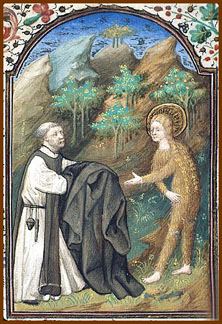Sometimes a story will arrive to fill a void. From the beginning of my time working on All the Saints it was my goal that it not be seen as “capital C” Catholic, but as “lower case c” catholic: that is, not institutionally religious, but drawing from and encompassing many cultures and experiences.
Still, because All the Saints clearly riffs on traditional Christian/Catholic imagery, I occasionally sensed a discomfort among Jewish friends, which gave me pause and occasioned a sense of personal artistic regret. I hoped for a way to illuminate our tortuous history together; a way to honor the ways in which the symbols I was using had caused so much pain.
I found the path on Santa Maria Road.
Santa Maria Road, as I wrote in my book, “arches north and eastward off Topanga Canyon Boulevard,” where it is defended by “Restricted Entry” signs; and, after passing through a shady glen of horse ranches, becomes “a dirt and dusty pathway into the southwestern reaches of the San Fernando Valley.”
When I stood, caked in Santa Maria’s dust, gazing into “this canyon of willow and sage,” I thought of one of several saints named Santa Maria: Saint Mary of Egypt, an early – and rare female – mystic hermit, who dwelled in the wilderness for forty years, her clothes worn away in decades-long penance, her body covered by her long tresses. It was easy to picture Mary of Egypt enraptured in this near-wilderness, and I couldn’t wait to return to my studio to portray her.
Unfortunately, a bit more research provided a historical source for the road’s name. Jesus Santa Maria, a Mexican settler from the 1870’s, endures on this sole Topanga Canyon road sign. Jesus lived in Topanga for decades, “hauling cords of manzanita into [Los Angeles] via the circuitous route of the period: north from his ranch to El Camino Real (now Ventura Boulevard); and from there, southeast into El Pueblo.”
Now my Road had a namesake; what it needed was an origin for Jesus’ last name. Wondering how someone acquired a last name like Santa Maria, I phoned one of my advisors on All the Saints, historian Stafford Poole, whose focus is on life in Colonial New Spain.
As fate (or the saints) would have it, Father Poole had recently researched this very theme – the naming practices of New Spain – with an emphasis on the Sephardic Diaspora. Indeed, he had just given a presentation on this very topic.
Father Poole informed me that nearly all Mexicans with last names such as Santa Cruz, Santa Fe, or Santa Maria are descended from the forced converts – conversos – from Judaism to Catholicism during Spain’s and Portugal’s periodic medieval pogroms. Forced to convert and take on uber-Catholic names, and still expelled from their home countries in 1492 by King Ferdinand (Yes, it wasn’t just Columbus who set sail that year), many became “Hidden Jews” who, over time, assimilated and adapted, integrated or reinvented themselves, into anti-Semitic societies in the New World.
As it happens, Doris, who is Jewish, has always joked that I should portray her as a saint; now I was about to invite her to let me do just that:
“Doris,” I began the phone call, “Remember how you always want me to portray you as a saint?”
“I want to be the Virgin Mary!” she startled me.
“Well,” I considered, “That’s actually why I called – but first let me tell you the story and see if you still want to do it.”
After I related the history of Santa Maria Road, and after Doris and I had a good cry, she insisted that she had to do this; and we set a date for me to photograph her.
 I think the resulting painting – her haunting visage as Our Lady of Sorrows, drifting above “this pilgrim’s dirt path, a Road affronted (as Jews have been for centuries) with “Restricted Entry” signs” – is perhaps my finest portrait. It certainly conveys the pain and endurance hinted at in its tale.
I think the resulting painting – her haunting visage as Our Lady of Sorrows, drifting above “this pilgrim’s dirt path, a Road affronted (as Jews have been for centuries) with “Restricted Entry” signs” – is perhaps my finest portrait. It certainly conveys the pain and endurance hinted at in its tale.
As we prepared my All the Saints exhibition for the Autry Museum, Doris confided that she was herself a hidden Jew: her parents elected to hide their heritage to facilitate assimilation into the Navy and a Wasp-only government society. Only in college did Doris discover – and embrace – her true inheritance. Her parents had erected “Restricted entry” signs on the branches of their family tree.


